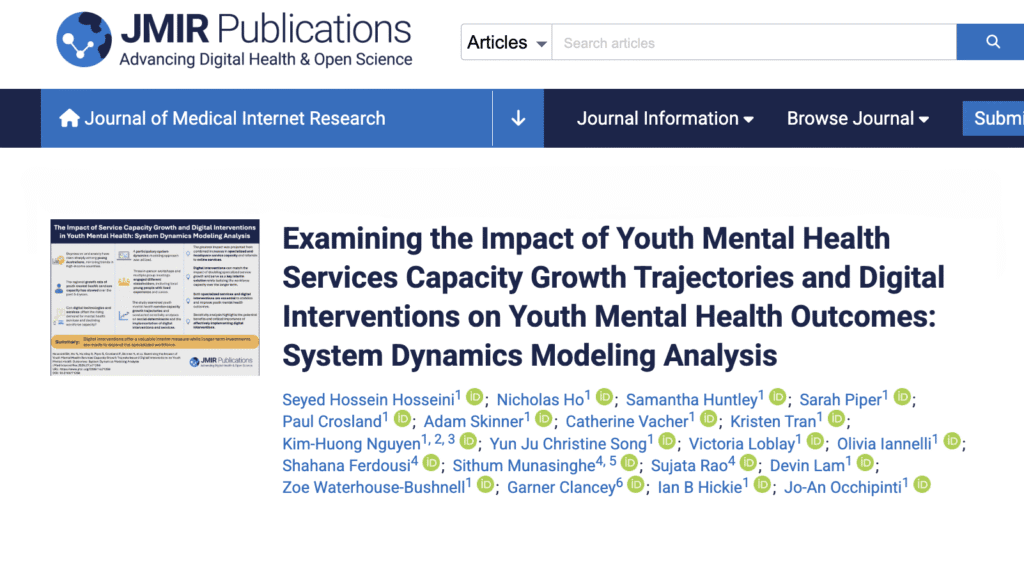
In our recently published research in the Journal of Medical Internet Research (JMIR), entitled “Examining the Impact of Youth Mental Health Services Capacity Growth Trajectories and Digital Interventions on Youth Mental Health Outcomes: System Dynamics Modeling Analysis”, we investigated the impact of digital interventions and different service capacity growth on Youth Mental Health.
Why is this important?
Depression and anxiety have risen sharply among young Australians, mirroring trends in high-income countries. In our case study (Western Sydney), the growth rate of youth mental health services capacity has slowed over the past 3–4 years despite the population growth in the region. The main question is whether digital technologies and services can offset the rising demand for mental health services and declining workforce capacity?
What did we do?
We used participatory system dynamics modelling to examine the impact of digital interventions and youth mental health service capacity growth trajectories. We also conducted sensitivity analyses on the uncertainties around social determinants of youth mental health and the implementation of digital interventions and services.
Key findings
The key finding is that “digital interventions offer a valuable interim measure while longer-term investments are made to expand the specialised workforce”.
Main results:
- The greatest impact was projected from combined increases in specialised and headspace service capacity and referrals to online services (this is applicable for Western Sydney Primary Health Network Catchment area).
- Digital interventions can match the impact of doubling specialised service growth and serve as a key interim solution while building the workforce capacity over the longer term.
- Both specialised services and digital interventions are essential to stabilise and improve youth mental health outcomes.
- Sensitivity analysis highlights the potential benefits and critical importance of effectively implementing digital interventions.
Access the paper
This is published in the Journal of Medical Internet Research (JMIR) and is accessible HERE.
Full Abstract
Background
Mental health (MH) issues are the leading cause of mortality for young people, highlighting the importance of timely, high-quality, and affordable care. However, recent trends show a deceleration in the growth of youth mental health (YMH) services capacity in Australia. Meanwhile, digital interventions hold significant potential to sustain and enhance YMH outcomes.
Objective
This study aimed to evaluate (1) the comparative impact of different services capacity growth trajectories on YMH outcomes and (2) whether digital interventions can offset rising demand and declining workforce capacity, to offer insights into strategic resource allocation for sustained improvements.
Methods
Participatory system dynamics modeling was used to investigate the impact of MH services capacity growth trajectories and digital interventions on YMH outcomes, with simulation results projected for 2025‐2035. The study focused on individuals aged 15‐24 years from a culturally diverse, rapidly expanding urban population in Australia. Outcomes assessed included years lived with psychological distress and disorders, MH-related emergency department presentations, and self-harm hospitalizations.
Results
Among the services modeled, doubling the growth rates for specialized MH services had the greatest impact (8.4% reduction in cumulative years lived with symptomatic mental disorder). Doubling the growth rates for specialized MH service, headspace (headspace National Youth Mental Health Foundation Ltd), and referrals to online services, together, could significantly enhance YMH outcomes. Compared to baseline, this strategic investment approach is projected to reduce cumulative years spent with symptomatic mental disorders, cumulative MH-related emergency department presentations, and cumulative self-harm hospitalizations by 14%, 6.4%, and 4.1%, respectively, from 2025 to 2035. Digital interventions alone produced comparable impacts to specialized services, but critically, could not prevent worsening outcomes when specialized services experienced degrowth. Combining digital interventions with expansion of specialized services yielded best outcomes with reductions of 15%, 5.1%, and 4.4% in these indicators, respectively.
Conclusions
The findings emphasize digital technologies as an effective interim and long-term solution to mitigate the slow and uncertain growth in the specialized MH workforce. However, simulation results showed that achieving sustained long-term improvements necessitates concurrent investment in expanding the specialized MH workforce, as digital interventions alone cannot compensate for degradation in specialized services capacity. A strategic combined approach offers the most effective pathway to improving YMH outcomes.
Keywords
youth mental health, public health policy, mental health services, system dynamics, Western Sydney

Let’s learn Systems Modelling together!
I share useful information about Systems Modelling here weekly.